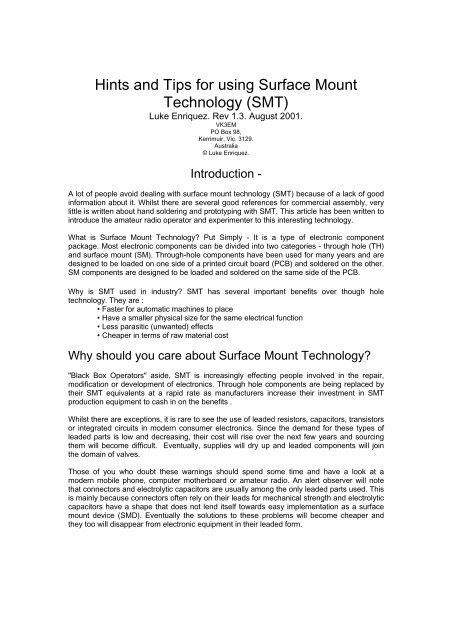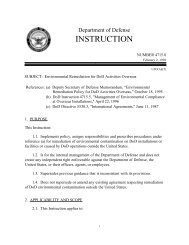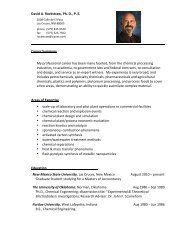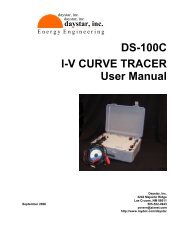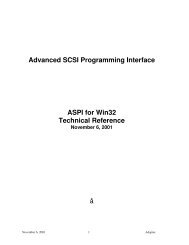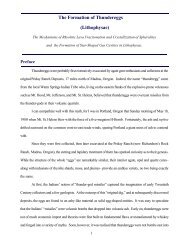Hints and Tips for using Surface Mount Technology (SMT) - OoCities
Hints and Tips for using Surface Mount Technology (SMT) - OoCities
Hints and Tips for using Surface Mount Technology (SMT) - OoCities
Create successful ePaper yourself
Turn your PDF publications into a flip-book with our unique Google optimized e-Paper software.
<strong>Hints</strong> <strong>and</strong> <strong>Tips</strong> <strong>for</strong> <strong>using</strong> <strong>Surface</strong> <strong>Mount</strong><strong>Technology</strong> (<strong>SMT</strong>)Luke Enriquez. Rev 1.3. August 2001.VK3EMPO Box 98,Kerrimuir, Vic. 3129.Australia© Luke Enriquez.Introduction -A lot of people avoid dealing with surface mount technology (<strong>SMT</strong>) because of a lack of goodin<strong>for</strong>mation about it. Whilst there are several good references <strong>for</strong> commercial assembly, verylittle is written about h<strong>and</strong> soldering <strong>and</strong> prototyping with <strong>SMT</strong>. This article has been written tointroduce the amateur radio operator <strong>and</strong> experimenter to this interesting technology.What is <strong>Surface</strong> <strong>Mount</strong> <strong>Technology</strong>? Put Simply - It is a type of electronic componentpackage. Most electronic components can be divided into two categories - through hole (TH)<strong>and</strong> surface mount (SM). Through-hole components have been used <strong>for</strong> many years <strong>and</strong> aredesigned to be loaded on one side of a printed circuit board (PCB) <strong>and</strong> soldered on the other.SM components are designed to be loaded <strong>and</strong> soldered on the same side of the PCB.Why is <strong>SMT</strong> used in industry? <strong>SMT</strong> has several important benefits over though holetechnology. They are :• Faster <strong>for</strong> automatic machines to place• Have a smaller physical size <strong>for</strong> the same electrical function• Less parasitic (unwanted) effects• Cheaper in terms of raw material costWhy should you care about <strong>Surface</strong> <strong>Mount</strong> <strong>Technology</strong>?"Black Box Operators" aside, <strong>SMT</strong> is increasingly effecting people involved in the repair,modification or development of electronics. Through hole components are being replaced bytheir <strong>SMT</strong> equivalents at a rapid rate as manufacturers increase their investment in <strong>SMT</strong>production equipment to cash in on the benefits .Whilst there are exceptions, it is rare to see the use of leaded resistors, capacitors, transistorsor integrated circuits in modern consumer electronics. Since the dem<strong>and</strong> <strong>for</strong> these types ofleaded parts is low <strong>and</strong> decreasing, their cost will rise over the next few years <strong>and</strong> sourcingthem will become difficult. Eventually, supplies will dry up <strong>and</strong> leaded components will jointhe domain of valves.Those of you who doubt these warnings should spend some time <strong>and</strong> have a look at amodern mobile phone, computer motherboard or amateur radio. An alert observer will notethat connectors <strong>and</strong> electrolytic capacitors are usually among the only leaded parts used. Thisis mainly because connectors often rely on their leads <strong>for</strong> mechanical strength <strong>and</strong> electrolyticcapacitors have a shape that does not lend itself towards easy implementation as a surfacemount device (SMD). Eventually the solutions to these problems will become cheaper <strong>and</strong>they too will disappear from electronic equipment in their leaded <strong>for</strong>m.
<strong>SMT</strong> MythsMany new facets of amateur radio <strong>and</strong> experimentation with electronics in general arehampered by the myths that surround them. Some of these myths are :• <strong>SMT</strong> needs special <strong>and</strong> expensive equipment• <strong>SMT</strong> components are hard to find• <strong>SMT</strong> requires professional PCBs• <strong>SMT</strong> requires special training <strong>and</strong> skillsTo use <strong>SMT</strong> <strong>and</strong> not get too stressed about it does require the following :• To have a steady h<strong>and</strong>• To practice your technique• To be invest in a good pair of tweezers• To have reasonable eyesight or use magnificationUn<strong>for</strong>tunately, there is not much you can do about the steadiness of your h<strong>and</strong>, but all theother obstacles can be easily overcome. The main emphasis of this article, is to explain howyou can work with <strong>SMT</strong> with the smallest possible investment of special equipment.
<strong>Tips</strong> <strong>for</strong> soldering <strong>SMT</strong> PartsGood soldering technique will come with practice, but these tips will guide you in the rightdirection. If you need to practice use <strong>SMT</strong> resistors as they are not damaged easily.• Keep the circuit board clean. Isopropanol or wood alcohol is suitable <strong>for</strong> removing light oils<strong>and</strong> grease. PCB's should always be washed under warm water, then oven dried at 60degrees Celsius <strong>for</strong> 10 to 15 minutes. H<strong>and</strong>le the PCB by the edge only <strong>and</strong> avoidtouching copper with your bare h<strong>and</strong>s.• Use the right soldering iron <strong>for</strong> the job. You don't need to purchase a temperature controllediron, special <strong>SMT</strong> tip or <strong>SMT</strong> hot gas reflow station. These tools might be used in industry,but only to save time <strong>and</strong> increase reliability.•All sorts of <strong>SMT</strong> soldering jobs can be done with the common Weller workstation. Theimportant point is select the right tip (i.e.: have several tips on h<strong>and</strong>). As with any solderingjob, the general idea is to have the joint up to temperature <strong>and</strong> soldered in a few seconds.Think about how much of a "heat sink" the joint will be <strong>and</strong> choose the tip based on that.Use of larger tips should be limited to areas of large solid copper plane (i.e.: groundplane). For all jobs except very very small parts, I use a the common Weller PT-8 7 tip asshown in Fig 3. With practice, you will learn what tip suits you best.Fig 3 - Soldering Iron <strong>and</strong> Tip suitable <strong>for</strong> <strong>SMT</strong>
De-soldering Small <strong>SMT</strong> Components1. Add excess solder to one side of the component.2. Whilst the side with excess solder remains molten, move your iron to the other joint <strong>and</strong>gently push the component off the pads.3. Clean up pads with solder wick.Note : The trick here is make one side of the component a larger thermal mass <strong>and</strong> heat thatside first. This may not work <strong>for</strong> all parts, especially those sitting on large ground planes.De-Soldering Small Outline Integrated CircuitsThis technique only works <strong>for</strong> SO-IC (50 thou spaced devices). Smaller devices may requirehot air <strong>for</strong> removal.1.) Apply flux to the IC pins.2.) Use solder wick to remove as much solder as possible from each pin.3.) Thread fine enamelled wire under one row of pins.4.) Secure one end of the wire on a nearby component (i.e. : Large Electrolytic).5.) Starting at the loose end, heat each pin <strong>and</strong> pull wire simultaneously. Pull the wire asclose to the PCB as practical. As the solder between the pin <strong>and</strong> pad melts, the wire willpop out <strong>and</strong> leave the pin st<strong>and</strong>ing free of the pad (<strong>and</strong> bent up slightly).6.) Repeat steps 3 to 5 <strong>for</strong> the other side.What parts can you recycle?Some <strong>SMT</strong> parts can be quite expensive when purchased in small quantities. All sorts of <strong>SMT</strong>parts can be recovered from surplus <strong>and</strong> junk equipment (providing it uses <strong>SMT</strong> parts ofcourse!). It will not only save you money, but give you good practice at de-soldering. TheVK3EM web site contains colour pictures of many <strong>SMT</strong> components so you can identify them.If you use recycled components, per<strong>for</strong>m an electrical check on them. Ceramic capacitorscause the most problems (they crack easily). Inductors, transistors <strong>and</strong> resistors can all beverified <strong>for</strong> correct operation. However, excessive heat may damage but not destroy thedevice.
Special TechniquesWhilst the purpose of this article is to detail the use of <strong>SMT</strong> with equipment most amateursalready have, there are a few exceptions. One of these is the use of hot air instead of asoldering iron. Hot air SMD rework stations are very expensive, but a much cheaper source ofhot air is a Weller Pyropen with a hot air tip (Fig 8). Usually used <strong>for</strong> heat shrink, the hot air tipmakes removing <strong>SMT</strong> parts a breeze (albeit a very hot one!). Use of flux around thecomponent to be removed will help the heat conduction into the part <strong>and</strong> the PCB.One of the draw backs with this technique is that surrounding components may also becomemolten <strong>and</strong> may possibly be blown off their pads. This is more of a problem in high densityPCB's with very small components when your trying to remove a large component, such asan IC. This can be overcome by folding up a small piece of brass sheet to fit over thecomponent in question. The brass provides a heat shield, <strong>and</strong> ensures surroundingcomponents remain on their pads.Fig 8 - Hot air tip on a Pyropen
<strong>Surface</strong> Tension - Your best friend?<strong>SMT</strong> is shrinking the size of component packaging at an alarming rate. How does onepossibly avoid shorting pins with spacings like 0.3mm or even less. The answer is simple.You don't! What do I mean by this! With such small pin spacings, you would go crazy trying tosolder each pin individually. With the aid of flux, you can increase the surface tension ofsolder to such a point that it difficult to bridge the gap between pins <strong>and</strong> cause a short.Several techniques exist, but an easy one is apply flux <strong>and</strong> make sure each pin is solderedwithout caring about shorts. Then, return to the pins with solder wick <strong>and</strong> soak up the excesssolder. This will leave solder between the pin <strong>and</strong> the pad, but not between the pins.Alternatively, you can simulate a wave soldering action by starting with a ball of molten solder<strong>and</strong> massaging it down a row of pins. This is the method I use to solder 100 pin TQFPpackages onto prototype boards. It helps to have the PCB a slight angle so that the moltensolder ball does not need to work against gravity. You must use lots of flux to keep thatsurface tension up.The ball of solder quite literally rolls along the fine pins, leaving a nicely <strong>for</strong>med joint betweenthe PCB pad <strong>and</strong> the pin, but without shorts between pins. No air or special solder pasteneeded. I did tell you surface tension was your best friend!Some soldering iron manufacturers now make special soldering iron tips that are hollow,spefically designed <strong>for</strong> use with this process. They are called wave tips. As always, a bit ofpractice helps. Find a dead mobile phone (full of very finely pitched <strong>SMT</strong>), <strong>and</strong> practiceyourself.ConclusionThis article has described some methods which may simplify the use of <strong>SMT</strong> <strong>for</strong> the amateurexperimenter. It is by no means complete <strong>and</strong> further in<strong>for</strong>mation can be obtained from theVK3EM web site http://www.geocities.com/vk3em.Sources of Parts :Quality Tweezers, Low Melting Point Solder <strong>and</strong> Flux can be purchased (small quantities)from :Mextronics Co Pty LtdFactory B, 84 Industrial DriveBraeside Vic 3195Telephone: 03 9587 3888Facsimile: 03 9587 3836AcknowledgementsThe author would like to thank Steve Merrifield VK3ESM <strong>and</strong> Bryan Ackerly VK3YNG <strong>for</strong>there help <strong>and</strong> advice in preparing this article. Some pictures <strong>for</strong> this article were extractedfrom the Tait T2000 Series II radio manual (with permission). Comments regarding this articleor any questions may be sent to VK3EM@hotmail.com or seehttp://www.geocities.com/vk3em. © Luke Enriquez, VK3EM.


